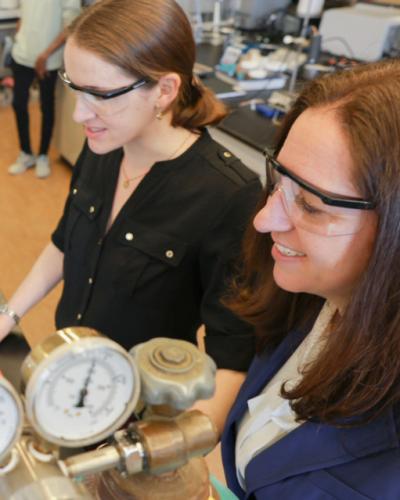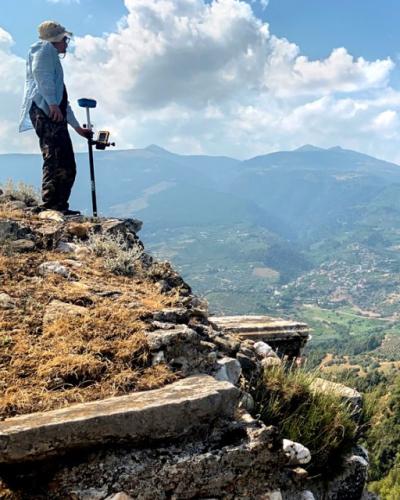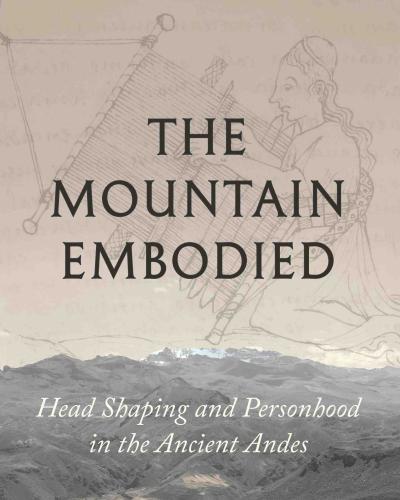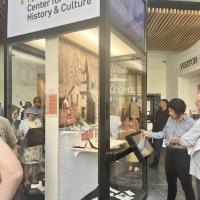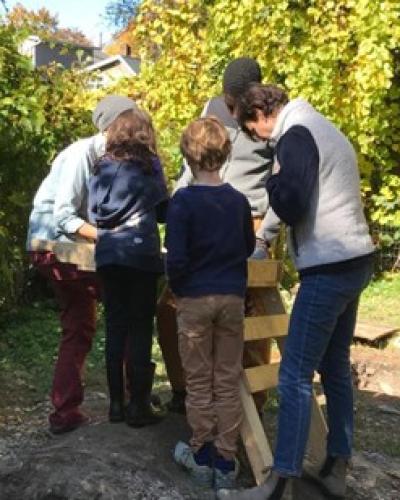Have you ever watched Indiana Jones and wondered what it would be like to travel the world in search of lost cities? Or have you ever walked through the Cornell Anthropology Collection with Professor Frederic Gleach and thought “Wow! Humans made this stuff!? And this man knows all about these objects?!” Then it seems to me that you may be interested in becoming an archaeologist or, at the very least, interested in the field of archaeology. This was certainly the case for me.
I came to archaeology after living seven lives already. I worked in finance in New York City, at a startup in San Francisco, a bakery in Sweden, and clerked for a law office in the town of Ithaca, all before I eventually made my way to Cornell’s campus to work for the Johnson Museum of Art. At the Johnson, for the first time in my life, I was surrounded by people who were passionate about the arts and that nurtured my interest in material cultural. It was at the Johnson Museum where I found a mentor that encouraged me to apply to graduate school for archaeology though Cornell’s Employee Degree Program.
The Employee Degree Program, also known as “EDP,” allows for Cornell staff members to work towards a degree in their field of employment. The program is a remarkable opportunity for someone like me, who would never been able to afford the tuition at this world-renowned institution. However, with the inability to take time off or accept grants, participating in a summer excavation project (which is when most excavations take place) became challenging to schedule or pay for. Thus, I was dangerously close to graduating from an archaeology program without ever having the opportunity to do…well, archaeology.
As a non-traditional student at Cornell University, the St. James AME Zion Church Community Excavation program has remedied that situation. This program and class have allowed for me to participate in a real archaeology excavation, and since it is designed as a mini-field school connected to a for-credit class, I feel warmly welcomed, even as a beginner. Since we excavate on Saturdays, I am able to work during the week and study in the evenings. For most field schools, you need to travel to a far-off location, which costs money. You usually need to pay tuition, visa fees, insurance, and the list goes on and on. However, this field school only costs as much as you would pay to take a class and gave me my own toolkit and trowel. I can honestly say I didn’t feel like a real archaeologist until I was handed that trowel and the little yellow rainproof field notebook for taking notes on all the artifacts I would uncover. But despite the accoutrements, the convenience, and much lower price tag, the best part of the St. James AME Zion Church Community Excavation project is the opportunity that it offers to learn more about the town and space I live in while working alongside local community members.
The class attached to the project, Field Methods in Community-Engaged Archaeology: Uncovering the Underground Railroad, was created in such a way to teach the students about field work and the methods needed to conduct research in the field, as well as to provide history and background of the physical location in which we are working. The syllabus for the class includes readings about Black Feminist Archaeology theory, the national laws from the 18th and 19th century, as well as examples of archaeology as resistance. These readings help provide a framework for myself and my classmates to understand the importance of the St. James AME Zion Church for the underground railroad system, as well as those who were saved by it. However, the strength of the class is not what we are getting out of the books and articles assigned for reading, but instead, it is what we are receiving from engaging with the local community that has tirelessly worked to preserve the true spirit of the St. James AME Zion Church.
On my first dig day at the site, I was welcomed by music and parishioners who were gathering around a hot coffee urn while setting up for a tag sale at the church. As I conspicuously eyed the candy dish, I was warmly welcomed by a church member to help myself to as many pieces as I wished. I only took one butterscotch hard candy, but that was all I needed for that moment to satisfy my early- morning sugar craving and to make me feel welcomed into a space to which I was a newcomer. Throughout the day, members of the church came out to the yard to help us dig or to offer us water. There was a real spirit of camaraderie made by the many different groups of people - Cornell students, church members, local high school kids, graduate students from other universities, professors- all coming together to work towards a common goal.
As the day carried on, we had various people, both young and old, stop by to see what we were doing. To be fair, it’s not every day that you see a plethora of people, both young and old, laying on their bellies scraping the dirt with tiny shovels (I would have been curious too). When the spectators asked what we were doing, I usually stayed quiet, not feeling fully confident to explain why I was pushing dirt through a screen. However, even if I did feel confident enough to explain the laborious, yet very important process of sifting dirt, I didn’t have to, so many other people were more than excited to share what they were experiencing or working on. I found this excitement to share with others and to engage with the community both heartwarming and inspiring. The excavation and its methods were no longer a learning tool to be dissected in the classroom or read about from a book. Here, in real-time, they became active learning tools. I watched as a professor who studies sites located in Armenia, pick up dirt and explain its composition and coloring to a small child. From another test unit I could hear a young volunteer shout “another one” every time that he had found a piece of coal… which was quite often.
When lunch time came, there were no boundaries between the communities, everyone dined in the yard together and discussed how our morning went or what we hoped to find (I noticed, with little surprise, no one mentioned coal). The conversation turned to local history, weekend plans, the tag sale taking place, and so forth, and though that was the first time that many of us had shared a meal together, it didn’t quite feel that way. It felt relaxed, and everyone was at ease. I attribute this comfort to the camaraderie that we built in the morning by collectively digging in the dirt and to the simple fact that we were there together, because we wanted to be.
Looking around the yard and seeing the different communities represented – church, Cornell, local elementary school, etc.- all eating sandwiches with our mud-stained hands and laughing together, it dawned on me that this is what makes archaeology so special, the community that we develop while on site, as well as the engagement with the local communities in which our site resides. Archaeology is about uncovering the past and learning about different communities and cultures that occupied or currently occupy a space. Every excavation will have a report written up from field notebooks, research will be done on the artifacts found, and eventually the information will be published. However, the St. James AME Zion Church project is special because it has thoughtfully incorporated so many communities and teaches the full archeological process, from excavating to publishing. This allows for anyone who has ever experienced that feeling of awe in seeing artifacts in a museum to become an archaeologist, even just for a day.
Though I was not able to take the summer and travel to Turkey or Israel to dig up 2,000- year-old buildings, in the end, I am okay with that. Participating in the St. James AME Zion Church Community Excavation program provided me with real experience in excavating while also giving me a way to deeply connect with my local community. I think that the most unique thing about this excavation is that the season for the site never really ends. We may stop digging in November, but the site will continue to be an active church, with tag sales and group lunches. We may no longer be sifting dirt through screens or excitedly talking about why we were laying on our bellies in the dirt, but we will keep working with the church community and local volunteers to interpret what was found. Because of this project, my first dig was in a space that was living, that had a heartbeat separate from what we were doing on the dig site. This excavation created a space for many different communities to come together and learn from and with each other. This project took church members, college students, elementary students, local Ithacans, professors and created another layer of community, the community of St. James AME Zion Church archaeologists.

